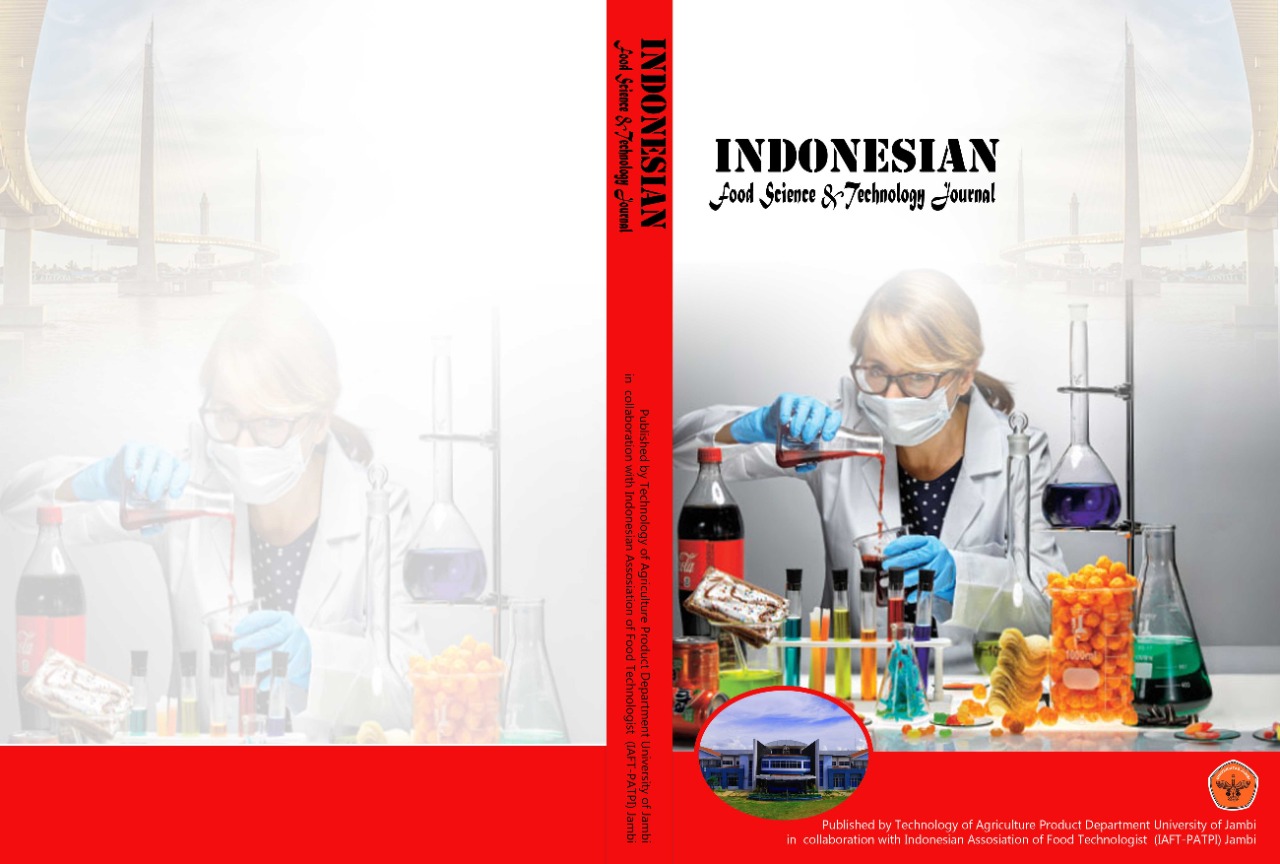The Effect of Concentration Areca Seed Extract (Areca Catechu L.) on Physicochemical and Sensory Properties of Pineapple Juice (Ananas Comosus L. Merr) As a Functional Beverages
DOI:
https://doi.org/10.22437/ifstj.v5i2.17303Keywords:
Functional beverages, areca seed extract, pineapple juiceAbstract
This study aims to determine the effect of concentration areca seed extract on the physicochemical and sensory properties of pineapple juice as a functional beverages , and to determine the appropriate concentration of areca seed extract to produce pineapple juice that has the best physicochemical and sensory properties. This study used a completely randomized design (CRD) consisting of 4 levels of treatment, namely the concentration of areca seed extract 0%, 1%, 2%, and 3% (v/v). Each treatment was repeated 5 times, so there were 20 experimental units. The results showed that the concentration of areca seed extract had a significant effect on the total soluble solids, the degree of warmth L* and a*, antioxidant activity, total tannin, vitamin C levels, and had no significant effect on the acidity (pH), and had a characteristic taste of pineapple chelate until the taste of pineapple is slightly chelate, the color is brown to very brown, it has a pineapple aroma to a strong pineapple aroma, with a weak aftertaste to a slightly strong after taste. The best treatment in making pineapple juice with areca seed extract was the concentration of 2% areca seed extract which contained 80.02% antioxidant activity, vitamin C 104.68 mg/100 g, total tannin 99.62 mg TAE/g, total dissolved solids value 20.980brix, color degree value L*29.48, a*7.06, b*20.80, acidity value (pH) 3.37, has a slightly brown color, aroma of pineapple (methyl ester and ethyl ester compounds), taste pineapple and not chelate, and has no aftertaste.
Downloads
References
Winarti S. 2010. Food Technology. Functional Food. GrahaIlmu, Yogyakarta: 137-165.
Rathod K, M Shivaprasad and Rajshekhar. 2015. Characterization and Extraction of Tannin Rom Areca Nut Waste and Using It as Rust Deactivator. J.Department of Chemical Engineering.HR College of Engineering and Technology, Karnataka, India. 3(2) ISSN: 2348-4098.
Harnowo I and Yunianta. 2015. Addition of Areca Seed Extract and Citric Acid on Physical, Chemical, and Organoleptic Properties of Sweet Starfruit Juice. J. Food and Agroindustry.3(3):1241-1251
Wiyono, TS, and Kartikawati, D. 2017. Effect of pineapple juice extraction method directly and osmosis with variation of boiling on the quality of pineapple syrup
Rohmana, Q.A., & Wahyono, P. (2012).Effect of Pineapple Juice (Ananas comusus) And Storage Time Against the Number of Bacterial Colonies and Milkfish (Chanos) Protein Content chanos) As Inner Learning Resources Biology Learning Material Planning Monera Kingdom. Journal of Education Indonesian Biology, 60-70.
Wetwitayaklung P, T. Phaechamud, C. Limatvapirat and S. Koekitichai. 2006. The Study of Antioxidant Capacity In Various Part of Araca catechu LJ Naresuanuniversity. 14(1):1-14.
Yenrina R, Novizar. N, Alfian. SL2014. Unripe Areca (Areca catechu. L) Nut Syrup as a Functional Beverages With Addition of Powdered Cassia Vera Extract. J. Asia Pacific Journal of Sustainable Agriculture Food and Energy (APJSAFE). 2(1): 17-22. ISSN: 2338-1345.
Marji, AM 2018. Effect of Addition of Juice from Various Parts of Pineapple (Ananascomosus L. Merr) on Curd Characteristics During Fermentation. thesis. Andalas University.
Herawati, N. Sukatinngsih, and Wiwik. 2012. Production of Functional Drinks Based on Red Dragon Fruit Skin Extract (HylocereusPolyrhizus), Roselle (Hibiscus Sabdariffa L.) And Salam Fruit (SyzygiumPolyanthumWighWalp). Herbal Based Functional Beverages. AGROTEK Vol. 6, No. 1, 2012:407-50
Sudarmadji, S., Haryono, B., and Suhardi. 2007. Analytical Procedures for Foodstuffs and Agriculture. Bogor: Liberty
Andarwulan NF Kusnandar and D. Herawati. 2011. Food Analysis.People's Diane. Jakarta.
Sudarmadji, S., Haryono, B., Suhadi. 1997. Analysis of Foodstuffs and Agriculture. Yogyakarta: Liberty.
Selvi AT, GS Joseph, and GK Jayaprakarsa. 2003. Inhibition of Growth and AflatoxinProductioninAspergillusflavus by GarciniaIndiica Extract and Its Antioxidant Activity. J. Food Microbial. 20:455-460.
Malangngi LP, S Meiske, Sangi, JE Jessy and Paengdong. 2012. Determination of Tannin Content and Antioxidant Activity Test of Avocado Seed Extract. J. MipaUNSRAT.1(1):5-10.
Setyaningsih, D., Apriyantono, A and Puspita, M. 2010.Sensory Analysis for the Food and AgroIndustry.IPB. Bogor.
Loebis. EH and L. Junaidi. 2015. Production of Jackfruit Extract Powder with Encapsulation Technique. Journal of Industrial Research Results. Vol. 28(2) : 78-87. ISSN 2089-5380.
SNI 01-3719-1995. Fruit Juice Beverages.National Standardization Agency BPOM Regulation No. 36 of 2013
Wahono, H. S and Pertiwi, Setyohadi, BR 2011.Effect of Apple Varieties and Fermentation Time by Yeast Sacaharomycescerevisiae as Pre-Processing Treatment of Syrup Characteristics.UniversitasBrawijaya, Malang.
Wang, CK, and Lee, WH 1996. Separation, Characteristics, and Biological Activities of Phenolics in Areca Fruit. J. Agric. Food Chem., 44(8):2014 - 2019.
Winarno, FG 2002.Food Chemistry and Nutrition. PT. Gramedia Main Library: Jakarta
Ismarani. 2012. Potential of Tannin Compounds in Supporting Environmentally Friendly Production. J. Agribusiness and Regional Development.3(2):64-55.
Nengah.1990. Study of Thermal Browning Reaction in the Process of Making Brown Sugar from Nira and Palm Oil.Thesis.IPB Postgraduate Program.
Rahayu, E. Purwasih, R. Hidayat, R. 2020. Effect of Addition of Pineapple Juice to Chemical and Sensory Characteristics of The Cascara Beverage. Subang State Polytechnic.Vol 11, No 2. P-ISSN: 2087-9679
Dokkedal, AD, Francisco, L. Lourdes CdS, and Wagner, V. 2007.Xeractinol – A New Flavanonol C-glucoside from Paepalanthusargenteus var. argenteus (Bongard) Hensold (Eriocaulaceae). J. Braz. Chem. Soc., Vol. 18, No. 2, 437-439, 2007. March 16, 2007; 1-3.
Anita, S. 2009. Study of Physico-chemical Properties, Functional Properties of Carbohydrates, and Antioxidant Activity of Komak Bean Sprout Flour (Lablab purpureus (L.) sweet).Essay.Faculty of Agricultural Technology.IPB. Bogor.
Winarno, F. 2004. Food Chemistry and Nutrition, Eleventh Issue. Jakarta: PT. Main Library Gramedia.
Mahdavi, D., Depandhe, SS, and Salunke, DK 1996. Food Antioxidant Tecnological, Toxicological, and Health Perspective. New York: Marcel Dekker, Inc
Neungnapa, R., Jia, Z., Xuew, D., Bao, YJ, and Yueming.J. 2008. Effects of Various Temperatures and pH Values on the Extraction Yield of Phenolics from Litchi Fruit Pericarp Tissue and the Antioxidant Activity of the Extracted Anthocyanins. Journal. Molecular Science, 9 , 1333-1341
Hannan A, Samen K and Tapan K, C. 2012. A Comparative study of In-Vitro Antioxidant Activity of
Duke JA 1985. Hand Book of Medicinal Herbs. Boka Raton. FL. CRC Press
Desmiaty, Y, Ratih H, Dewi MA, Agustin, R 2008, 'Determination of Total Tannins in Dutch Teak Leaves (GuazumaulmifoliaLamk) and Blood Sambang Leaves (Excoecaria bicolor Hassk.)Colorimetrically with Prussian Blue Reagent', Ortocarpus, 106 -109
Supriyanto, R 2011, 'Study of Speciation Analysis of Metal Ions Cr(III) and Cr(VI) with Tannic Acid from Gambir Extract using UV-VIS Spectophotometry', J. MIPA Science, April 2011, Vol. 17, No1, ISSN 1978-1873.
Vanimakhal, RR and Ezhilarasi, BS 2016. Phytochemical Qualitative Analysis And Total Tannin Content In The Aqueous Extract Of Areca Catechu Nut. Asian Journal of Biomedical and Pharmaceutical Sciences, Department Of Zoology, Ethiraj College For Women, Chennai-8, Tamil Nadu, India.
Rivai H, E Widiya and Rusdi. 2013. Effect of Comparison of Ethanol and Water Solvents on Total Phenolic Compound Levels and Antioxidant Power of Soursop Leaf Extract (Annonamuricata L). J.Pharmaceutical Science and Techno.18(1):35-42.
Dewi P. 2020.Qualitative and Quantitative Test of Secondary Metabolt Ethanol Extract of Awar-Awar Leaf with UV-VIS Spectrophotometer Method.Pelta Mas College of Pharmacy, Palu.ISSN 2656-8233.
Santoso R. 2015. The Effect of Formulation of Young Coffee Leaves with Old Coffee Leaves on Chemical and Organoleptic Properties of Kopilibtukom Leaf Tea.J. National FatetaUnja.Jambi.
Murdianto, W., and Syahrumsyah, H. 2012. Effect of sodium bicarbonate on vitamin C levels, total dissolved solids and sensory values of carbonated pineapple juice. J. Agricultural Technology, 8(1), 1-5..
Lestari, B. 2020.Characteristics of Candidates for Functional Beverages with Pineapple Juice with the Addition of Turmeric Extract.Essay.Sriwijaya University.
Sinchaipanit, P., Ahmad, M., and Twichatwitayakul, R. 2015.Kinetics of ascorbic acid degradation and quality changes in guava juice during refrigerated storage.J. Food Nutrit. Res., 3(8), 550-557.
Lim T, K. 2012. Edible Medicinal and Non-Medicinal Plants. London New York. Springer Dordrecht Heidelberg. Page: 489-91
Irina, I. and G. Mohamed. 2012. Biological Activities and Effects of Food Processing on Flavonoids as Phenolic Antioxidants. Nancy University ENSAIA: France. DOI: 10.5772/30690.
Mirnawati and Sevenline. 2019. Preference of Several of Starch n Use as Edible Coating. Boindustri Journal.Vol. 02. No.01. University Trilogy
Downloads
Published
How to Cite
Issue
Section
License
Copyright (c) 2022 Daniel Tua Purba, Addion Nizori, Dian Wulansari

This work is licensed under a Creative Commons Attribution 4.0 International License.







